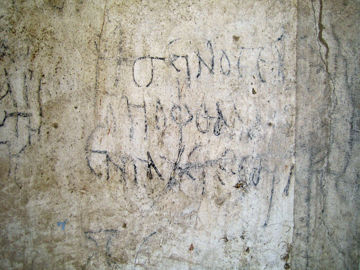Record of healing
Ἡγεῖνος εἶπ̣[εν]
τ̣ὸν̣ ὀφθαλμ[ὸν]
ἐν τάχει ἐθαραπεύ̣[θην]
| Translation: | “Hyginos said, ‘My eye was quickly healed’.” |
|---|---|
| Findspot: |
Smyrna, Basilica
(Agora.1)
|
| Language: | Greek |
| Writing Style: | charcoal |
|
|
| Apparatus Criticus: | 1. Read Ὑγῖνος. The name is well represented in Ionia and Caria, see LGPN 5A.440, 5B.418, with an example in the former from Smyrna. 3. The mention of the swiftness of the cure is intended to point to the power of the divinity who effected the cure. Chaniotis, A. 2009a. “Ritual Performances of Divine Justice: The Epigraphy of Confession, Atonement, and Exaltation in Roman Asia Minor.” In H. M. Cotton, R. G. Hoyland, J. J. Price, and D. J. Wasserstein, eds., From Hellenism to Islam: Cultural and Linguistic Change in the Roman Near East: 115–53. Cambridge. discusses this phenomenon, citing examples. We quote from his email of 29 January 2015: “In an epitaph, Lord the Almighty is asked to punish a murderer fast (SEG 50 (2000), 1233 (Neoklaudiopolis, AD 237): Κύριε Παντοκράτωρ· σὺ μὲ ἔκτισες, κακὸς δέ με ἄνθρωπος ἀπώλεσεν· ἐγδίκησόν με ἐν τάχι). The god is invited in a subtle way to prove his endless power not only by punishing the murderer, but also by inflicting the punishment fast (ἐν τάχι). This is a strategy known from magical texts. In order to provoke the anger of the gods and demons, the magician often urges them to act fast (ἤδη ἤδη, ταχύ ταχύ). And in a confession inscription (Petzl, Beichtinschriften no. 69), the power of the god is shown by the fact that he punishes Tatias and her son within a day (μονημέρῳ κολάσει ἀπηλλάγη).” |
| Bibliography: | Bagnall, R. S. et al., Graffiti from the Basilica in the Agora of Smyrna (2016): 265-266. Bagnall, R., Everyday Writing in the Graeco-Roman East (2011): 19 and 21, fig. 9. SEG 61.968. |
| Suggested Citation: | AGP-SMYT00272, The Ancient Graffiti Project, <http://ancientgraffiti.org/Graffiti/graffito/AGP-SMYT00272> [accessed: 10 May 2024] |
| Contributions: |
Editor: Roger S. Bagnall Principal Contributor: Roger S. Bagnall Last Revision: 2016-10-03 |
